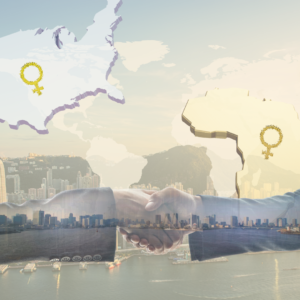Photo Credit: Reuters/Mike Hutchings
It has been twenty years since the end of Apartheid in South Africa, but student protests erupting across the nation’s universities suggest that two decades of African National Congress rule have not been enough to meet its citizens demands for socioeconomic equality. Images of students under the moniker “Fees Must Fall” battling police and private security who yield rubber bullets and tear gas are disturbing reminders of the country’s tempestuous past. At the same time, other students, who are angry over perpetual shutdowns due to a minority of student protesters, have staged their own counter-protests advocating their right to learn. The South African Constitution guarantees the right to receive a basic education to all, and South African university students rightfully argue that this right is being infringed upon via the rising cost of education in the country.
It may seem ironic that in protesting their right to free and decolonized education, groups of students have forced shutdowns at many of the nation’s top universities, most notably the University of Cape Town and the University of the Witwatersrand. But, South African history has shown that the tactic of utilizing obstructionist protests is effective in spurring change. The ANC government and campus administrators are in a race to address the feasibility of student demands for free education in a developing economy, else the much-needed graduation of many professionals be delayed, putting treacherous additional stress on the under-skilled workforce and thus the economy.
The “Fees Must Fall” movement was born in October of 2015, in response to announcements that both the University of Cape Town and the University of Witwatersrand would be implementing approximately ten percent fee increases the following year. The subsequent events created a domino effect in which a number of students from the “Rhodes Must Fall” movement—which pushed to remove a statue of colonialist Cecil Rhodes, the founder of the University of Cape Town, from its campus—again joined forces to protest the country’s education system as a whole. In addition to the issue of fee increases, grievances included a lack of adequate student housing, the burden of high fees on poorer students, and eventually the arrests of numerous student protesters over the course of the weeks that followed. Most student protests across the country culminated with the announcement by President Jacob Zuma that the ANC government would ensure a zero percent increase in fees for 2016 by providing funding and appointing a task force to look at broader issues of “free education, institutional autonomy, racism, accommodation and what students call ‘black debt’.”
However less than a year later, in September 2016, Higher Education Minister Blade Nzimande shifted responsibility for preventing fee increases from the ANC government when he announced that individual institutions should determine fee increases for 2017—with an eight percent cap on increases. This announcement sparked current protests starting in September 2016, in which escalating violence has led to campus-wide shutdowns. A solution has yet to be reached as the University of Cape Town and the University of the Witwatersrand, among others, remain closed for business.
It’s no secret that South Africa remains one of the most socially and economically unequal societies in the world. In 2011 its GINI coefficient, the most commonly used measure of inequality, was 63.38, an increase of four points since the end of Apartheid in 1994. Universities like the University of Cape Town have released data to show they are enrolling more black African students and fewer white students each year. Despite this, white and international students still make up nearly half of the students at the university, while white South Africans make up only nine percent of the national population.
Similarly, a disproportionate amount of the housing on the University of Cape Town’s campus—housing which is competitively assigned—goes to upper-class white and international students. Indeed, international students are guaranteed housing on campus, while poorer South Africans are forced to either foot the bill for expensive housing in the neighboring areas or face long commute times from their homes to class each day. For students whose families were subjected to the Group Areas Act, which separated housing areas based on racial grouping and relegated many non-Europeans to least developed areas during the era of Apartheid, commuting from townships on the outskirts of the city can take upwards of forty minutes each way.
South Africa does offer a National Student Financial Aid Scheme for lower-income students, but the country’s unemployment rate has increased by three percent since 1994: the reported current rate is twenty-five percent—and in actuality may be closer to forty percent—which means that after graduation many students head back to townships with thousands of dollars in debt that they cannot feasibly repay. Furthermore, the costs of transportation, housing, books, and other resources that are harder for black students, who are disproportionately poorer, to access result in a drop-out rate of up to a third of black students. While protesters have been condemned for damaging property—burning colonialist pictures at the University of Cape Town and a library at the University of Kwazulu-Natal to make a statement on whether society values items and institutions more than poor and minority students’ access to them, the points they raise are gaining traction across the nation.
While university administrators acknowledge the validity of many of the protestors’ grievances, the administrators’ plea for a peace accord revolves around the fact that the suspension of classes has jeopardized the success of South Africa’s National Development Plan, which needs 1.6 million students enrolled in university in the year 2030 in order to meet the country’s growing demand and needs for healthcare, education and other services. However, whether graduation this year is possible or not, the plan requires that at least two percent of South Africa’s GDP go to higher education. At present, South Africa spends only 0.8 percent of its GDP on higher education. The ANC government says that with a GDP growth rate of only 0.4 percent, the budget is already constrained, and to fund free higher education would put a pressure on the national budget that would devastate the South African economy. It argues that the twenty-eight billion rand allocated for university subsidies and fourteen billion rand for the national funding scheme for 2016/2017 is already pushing it.
New data, released in the last few years, challenges the government’s claims. First, a 2012 report commissioned by the higher education ministry was leaked after an activist group filed a freedom of information request. The report outlined a model for free higher education for students whose income fell below 188,000 rand, which is more than the national average income, showing that such a design is indeed possible. Then, the Democratic Alliance, the ANC’s major opponent, released a statement outlining their plan for funding higher education. They proposed to pay in full the cost of study for students whose annual household income is R200,000 or less, to pay sixty-six percent of the full cost of study for students with household incomes between R200,000 and R350,000, and to pay thirty-three percent of the full cost of study for students with household incomes between R350000 and R500000, again showing that a national plan to fund free higher education is indeed feasible.
The DA statement also noted that since 2000, “state subsidies as a proportion of university income fell from forty-nine percent to forty-percent in 2014.” These reports indicate that the ANC is aware that free higher education is possible for lower-income students, and lend credence to arguments that they perhaps are just unwilling to address necessary steps to its implementation. Indeed Gwede Mantashe, the ANC secretary general, stated, “I’m not the minister of education [but] if I was, my first reaction would be to close [the universities]. For 16 months. And open them after six months, and close the residences for six months. After a year, people will know higher education will be important for the future.”
Mantashe’s preference to teach protesters a lesson by recommending shutdowns rather than taking steps to implement a national education plan is ironic in light of the oppressive apartheid government his party defines themselves as having fought so hard against. The government’s relegation of the decision on whether to raise university fees to university officials simply shifts blame, and the lack of government commitment to action has twice shut down the country’s universities. These actions are harmful both to the institutions of higher learning, which are dropping in global rankings and, more importantly, to the students who are putting their own educations on the line in order to demand change. The lack of transparency in governance, epitomized by the fact that the 2012 report which outlined the feasibility of free higher education was only released after a freedom of information request, is troubling and indicative of a deep-rooted problem of disseminating the blame within the South African government.
While the ANC government blames the country’s still-developing economy for its inability to fund higher education, new data suggest that, with good policy, free education, or at the very least—better funding for institutions of higher learning—is possible. While South African students battle over their right to protest to suspend classes or to attend them, both can agree that they believe they are doing what is necessary to secure a better future for education in the country, whether it be by making education more inclusive and affordable or by finishing their studies to contribute to the strained and developing economy in South Africa. Today, even first world countries with strong economies, like the United States, insist that they are not yet ready for the cost of free higher education. In this light, the ability of South African students to inspire policies that reject the idea that free education is out of reach for countries with developing economies is a major assertion in global development policy. However, in order for these policies to come to fruition the South Africa government needs to stop deflecting blame to Universities who require either student or government funding to run, and take responsibility for working with both institutions and students to come to a peaceful solution.





